Session 4
1. Session 4
1.4. Inquiry 2
Session 4: Providing for Play
Inquiry 2: The Circle of Facilitation
Facilitating children’s play is an ongoing process. The child care provider’s responsibility includes setting up the space, participating in and facilitating play experiences, and observing activities. Together, these three processes are referred to as “The Circle of Facilitation.”
While there isn’t a “correct” starting place on the circle of facilitation, child care providers often begin with observing children so that they can learn the interests and needs of each child.
Each component in the circle of facilitation is important on its own and in combination with the other components.
By constantly evaluating all levels of play, a child care provider can provide an exciting, dynamic, and encouraging play space.
Setup
There are many highly desirable characteristics of children’s play spaces and many considerations child care providers must make. The following guidelines must be met to ensure developmentally appropriate play spaces.
Safety
- The child explores freely and safely. For children who have specific needs (e.g., impaired sight or hearing, limited mobility, and so on), special considerations may need to be made.
- Equipment and materials are in good condition, not broken.
- Play spaces are visible to child care providers to ensure proper supervision (being able to see all children at all times).
- Safety standards are followed (e.g., playground equipment is in good repair).
- Outdoor areas are safe (e.g., free from glass, appropriate cushioned surfaces under fall zones, and so on).
Movement
- Children need daily opportunities for large and small body movement (fine and gross motor play).
- Modifications are made for children who use mobility devices to ensure that they have free movement within the facility. Spaces are flexible to accommodate children’s needs and interests.
- There is adequate space for the children in which they can pretend play, use sand and water, make crafts, read, play with manipulatives, and so on.
Self-Expression
- Children have many opportunities to use materials in different ways.
Interaction
- Younger children prefer smaller groups and often engage in individual activities, while older children often play together and need more space. A variety of play materials is always required in sufficient quantity (especially to minimize the need to share for younger children.)
Privacy
- Children have the opportunity to be alone in a visible, quiet, safe space.
Adequate and Accessible Materials
- There are enough materials for the children to engage in a variety of play experiences, minimizing the need to share, take turns, and wait to play.
- Materials are stored on low, open shelves for easy access by children.
Choices
- Play areas have a variety of materials that are developmentally appropriate for the age group.
Child-Sized Furnishings
- Furniture and fixtures, such as sinks, toilets, displays, climbers, chairs, and tables, are size-appropriate for the children who use them.
- Children’s feet are able to touch the ground when they are sitting on chairs.
Defined Play Spaces
- Play spaces are well laid out to create specific interest centres (manipulative/table-top centre, quiet/reading area, water table, sand table, large muscle area, art centre, dramatic play/housekeeping area) and other activities.
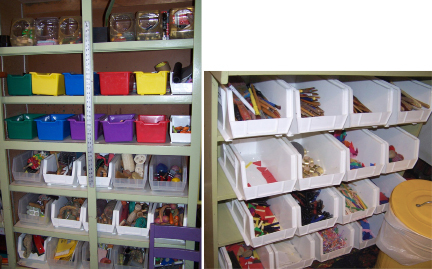
Sherry Duncan
Organization of Storage Space
- Organize craft supplies and other manipulative materials by placing coloured dots on the containers that hold puzzles, beads, boxes, crayons, and so on. Place matching dots on the shelves where these items are stored so that children can easily identify where each item should go.
-
Trace the outline of tools on a pegboard so that children can hang tools in the appropriate places.
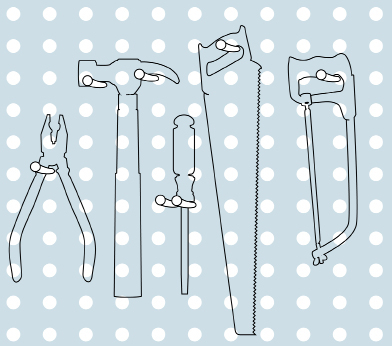
- Draw symbols on cupboards or boxes to indicate which items are stored in which spaces.
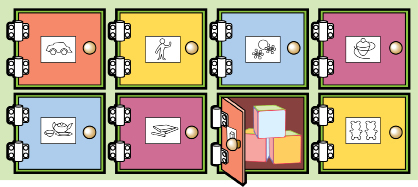
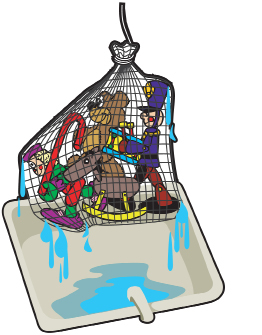
© adapted from 2009 Jupiterimages Corporation
-
Place wet toys from the water table in a net bag hung over the water table or in a sink, so that water can drain from the toys.
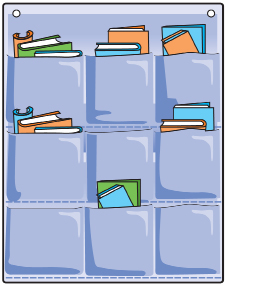
-
Place books in a book organizer, similar to a shoe organizer, that has pockets large enough to hold books. Hang the book organizer on the wall or on another vertical surface, such as the back of an upright piano or a bookshelf.
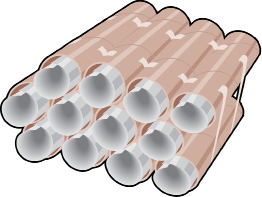
- Cardboard tubes, such as those used for mailing calendars and posters, or paper towel rolls can be glued together to create a place for storing children’s artwork and keeping it wrinkle-free.